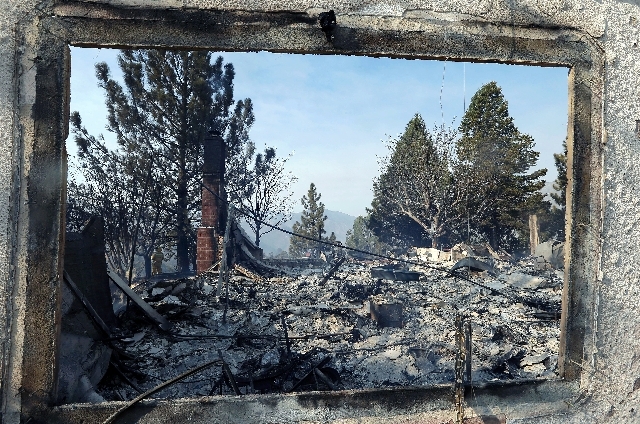Residents watched, waited until flames descended
PALMDALE, Calif. -- Smelling smoke, Scott Reader watched and waited for hours as a huge plume drew ever closer to his home in the rural community of Lake Hughes in northern Los Angeles County.
It didn’t take much for him to decide when it was time to get out.
“We saw flames and that was it,” Reader said. “That’s all we needed to see.”
He packed some belongings into a trailer, loaded up the dogs, and he and his girlfriend drove to a Red Cross shelter in nearby Palmdale on Saturday.
They were still there on Monday along with dozens of other people who fled a vast wildfire that chewed through more than 46 square miles of old chaparral and threatened two hamlets at the edge of Angeles National Forest.
Firefighters had doubled containment of the blaze to 40 percent by Monday, as cool, moist air moved in to replace torrid weather. The flames moved out of rugged mountains and onto the floor of the high desert Antelope Valley, where the fire became easier to fight.
“The fire moved into an area where vegetation changed from real dense to real sparse,” U.S. Forest Service spokesman Matt Corelli said.
With only widely scattered homes in the area, firefighters were able to work more on attacking flames than on structure protection, he said.
At least six houses have been destroyed by the fire, nine more were damaged, and 2,800 people fled 700 homes in Lake Hughes and Lake Elizabeth, 45 miles northwest of downtown Los Angeles.
During the weekend, flames were fanned by unpredictable winds that pushed hotspots in different directions.
Reader, 44, said he was astounded to see how fast-flying embers blew from a ridge a half-mile away and across Lake Hughes to suddenly ignite brush near his backyard.
“It just jumped right over the lake, no problem,” he said.
Reader received word that his house survived, but the fate of neighbors’ homes, some of which have been occupied for generations, was still unclear.
“I’m absolutely nervous, I’m nervous for all of them,” he said.
About 2,100 firefighters took on the flames, aided by water-dropping helicopters and airplanes unleashing loads of retardant across the flanks of the fire.
The cause of the fire was under investigation. Three firefighters had minor injuries, but no one else was hurt.
Despite the improved situation, evacuations remained in effect while firefighters checked communities for hazards such as hotspots, downed power lines, damaged gas lines and propane tanks.
Smoke from the Southern California wildfire and from Nevada fires hung over Las Vegas, where Clark County officials advised Monday that it could bother sensitive people such as those with respiratory conditions.
Also in the West, two major wildfires were burning in northern New Mexico, and weather conditions were not expected to be helpful to firefighters on Monday.
The Tres Lagunas fire north of Pecos in Santa Fe National Forest had grown to 12 1/2 square miles, causing smoke to spread across much of the region.
It previously prompted the evacuation of about 140 houses, mostly summer residences.
Drier and windier weather was expected, a change from Sunday, said interagency fire management team spokeswoman Denise Ottaviano.
“It’s going to be challenging,” she said
Elsewhere in New Mexico, the Thompson Ridge fire near Jemez Springs remained at nearly 3 square miles. Forty to 50 houses were evacuated late last week.
A light gray haze blanketed the Sangre de Cristo Mountains to the east of Santa Fe and a thicker haze nearly obscured a view from Santa Fe of the Jemez Mountains to the west.
---
AP writer Christopher Weber contributed from Los Angles. Paul Davenport in Phoenix also contributed to this story.






















